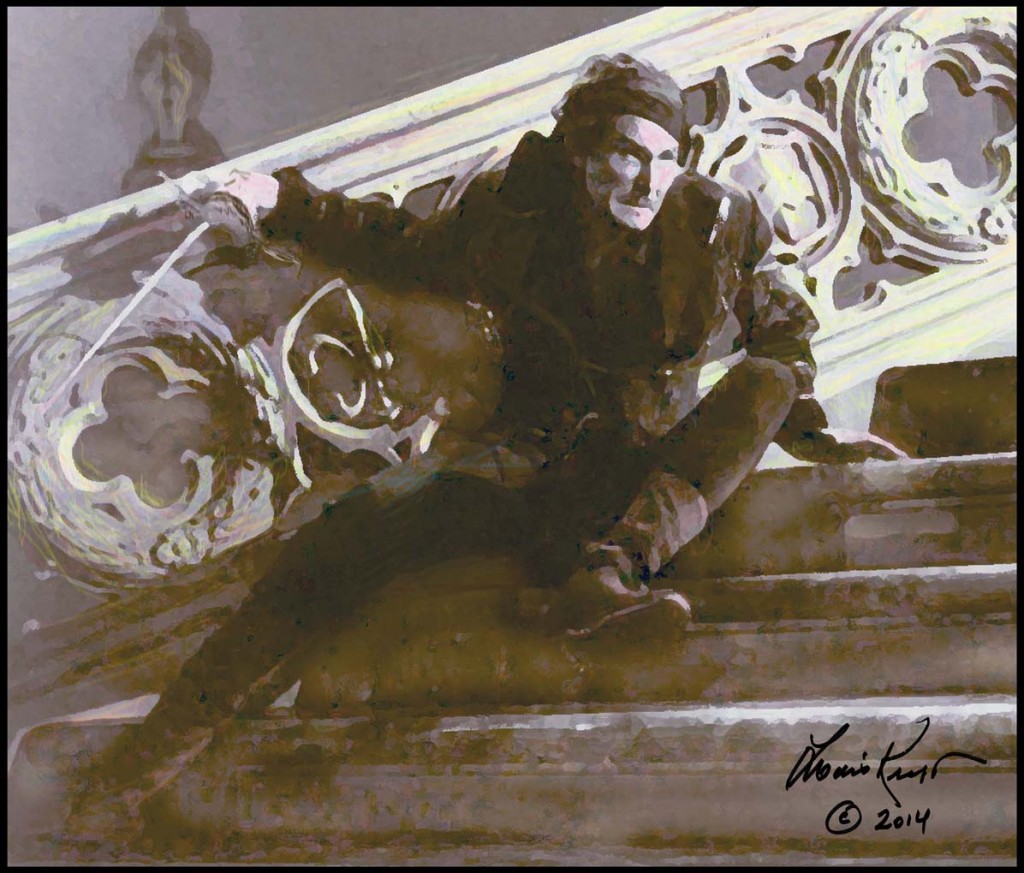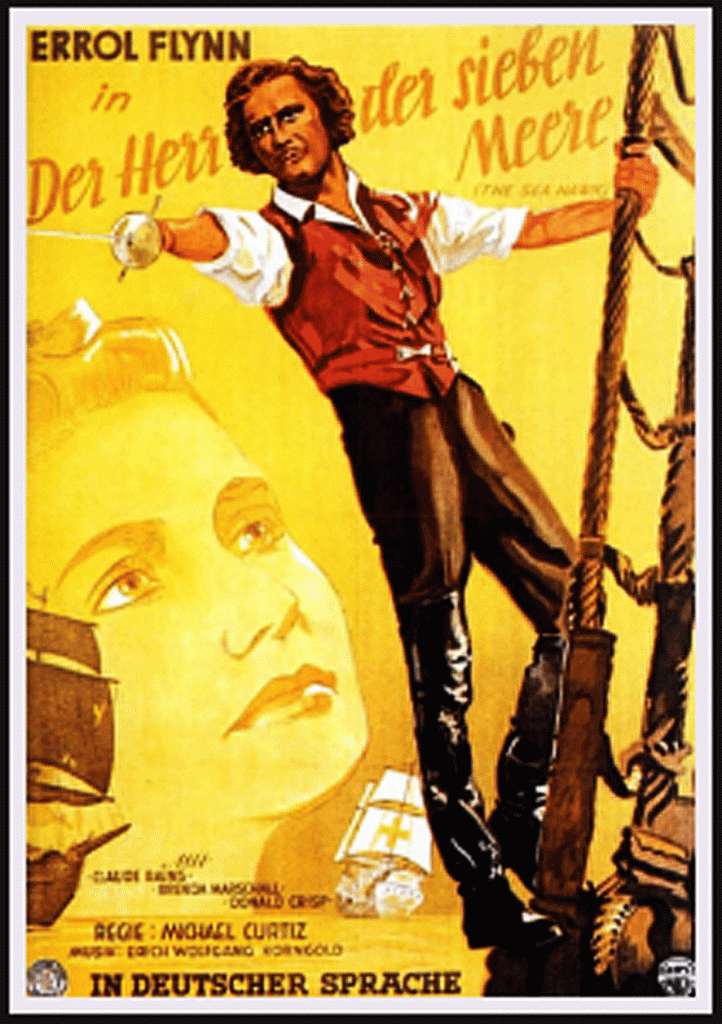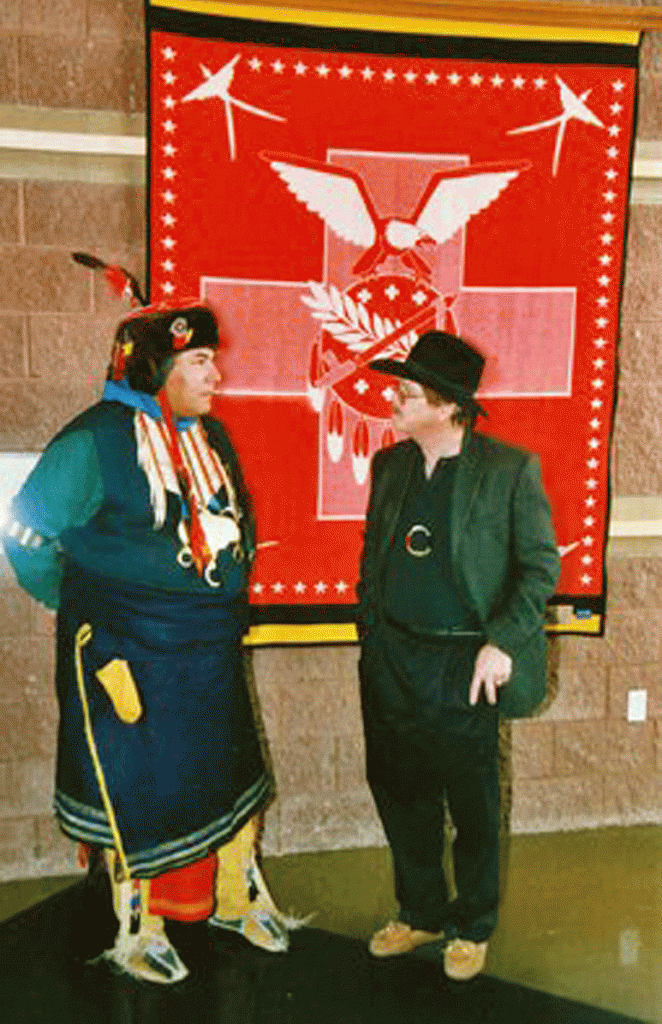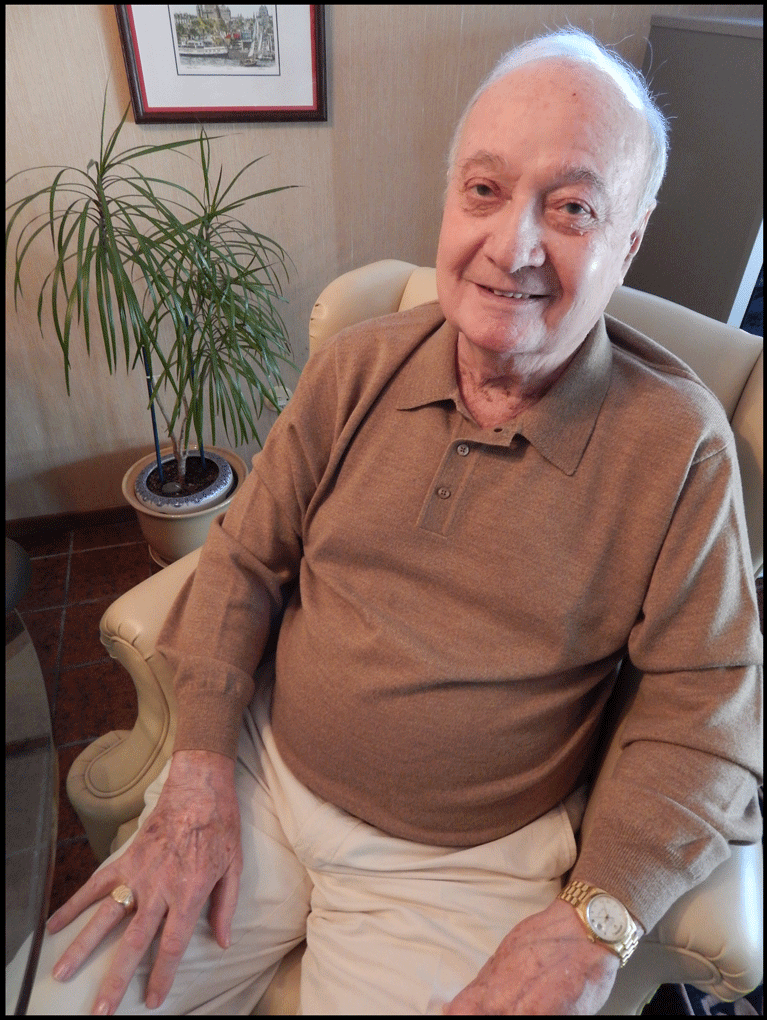Website & blogs © Louis Kraft 2013-2020
Contact Kraft at writerkraft@gmail.com or comment at the end of the blog
Cheyennes have been coming to life every morning for over a week.
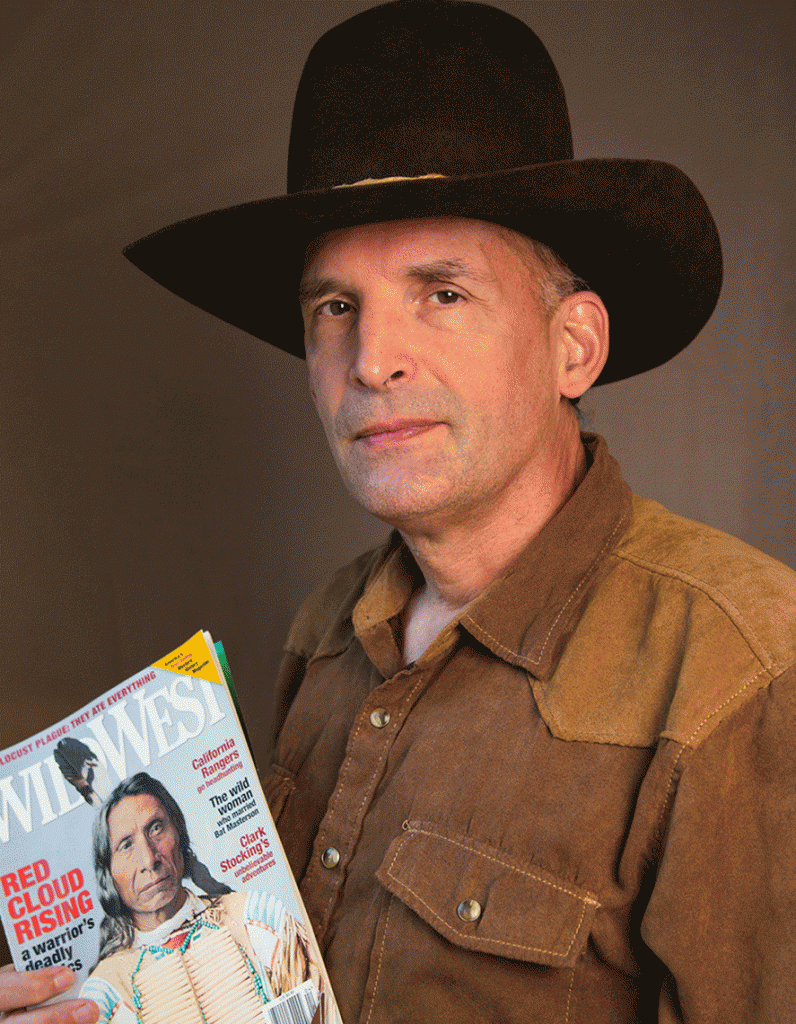
Greg Lalire has been a good friend of mine since the dawn of time. He’s charming, understanding, and a good fellow to know (not to mention that he is a great editor). Jennifer Berry of the Weider History staff took this photo. I like that Greg chose to display the Wild West cover with Red Cloud. (photo © Greg Lalire 2014)
I don’t have writers’ block. I never have writers block; it’s just a matter of finding the time and regulating it accordingly.
I’m certain good pal and great editor at Wild West Greg Lalire might have a few words to say about this (but I’m not going ask him to share). Probably something like, “Hey Kraft, get the lead out and do some real work, work that’s actually usable in a Weider History Group publication.” Everything I promise Greg (well almost everything) is a dollar short and I hate to say it but sometimes years late. At best I’m the little boy who cried “wolf” one time too many.
My great friend Glen Williams, upon seeing Greg’s (I assume) dust jacket portrait for Captured: From the Frontier Diary of Infant Danny Duly, said he looks like a gentleman. Greg does and is. He is a class act over and over again and I count myself lucky to know him.
For more on Mr. Lalire and his immediate future see below.
“Better late than never”
As Don Juan de Maraña once said (actually this is what Errol Flynn as Don Juan once said in Adventures of Don Juan, 1948): “You know what they say, ‘Better late then never.'” Of course Mr. Flynn’s Juan had just been caught again. But this time he was innocent and tried to protect the offending lady and avoid a duel.
Sorry, but I couldn’t help myself. If you haven’t seen Flynn’s Don Juan, do yourself a favor and see it. I guarantee that it will be a very enjoyable two+ hours of your life.
Errol Flynn? Look at the above Don Juan image—that’s Flynn. Who was Flynn? He was a combination of a graceful athlete and a natural actor. He lived his characters long before Monty Clift, Jimmy Dean, and Marlon Brando claimed the limelight in the 1950s. Of course Flynn got pounded for this.
Again, look at the Flynn Don Juan image above. We’re talking sword fighting ladies and gents, and it isn’t easy to do. It’s strenuous. Sword fighting for the stage or screen is done without protective gear (other than perhaps knee or elbow pads). One slip, one misplay, one loss of concentration can mean the loss of an eye.
Sword fighting for screen or stage is by the numbers just like dance. You know what your partner is doing and they know what you are doing. If you mess up and don’t back off (or your partner messes up and doesn’t back off) someone is going to get hurt and blood—real blood—will flow. I’ve been there and done this and I guarantee that the blood is red and afterwards sparks will fly.
Stage combat for the screen or theater is different than competition dueling, which is boring to watch. I had front row seats at the 1984 Olympics in LA and was bored to death. Slash, thrust, parry, lunge, point. Ten seconds. Ready. Fight. Nine seconds and another point is scored. This is not dramatic.
To create a dramatic duel on film is a multi-talented grouping of people: a director, duel choreographer, director of photography, actors, stunt men, and most important an editor to piece the filmed cuts together. Without this combination you have nothing. And with it, you have the makings for an exciting duel. This doesn’t happen often. When you see a good duel, give credit to where credit is due.
A Flynn film list
Some people are big on creating lists. I’m not, but here’s a short list that I can live with. Not the end of the world, but let’s say this: “Kraft, pick five Errol Flynn films; everything else will be destroyed.” I can do this. In no order the five films are:
- Adventures of Don Juan
- They Died With Their Boots On
- Gentleman Jim
- The Sea Hawk
- Uncertain Glory
All five films were released in the 1940s. You want to see Flynn, see these films. I can name a top 10 film list and neither Captain Blood nor The Adventures of Robin Hood make the list. I don’t buy into the cliché, Flynn, Indian wars, or anything else, and never have. For this blog I had originally drafted, “Email me if you want to know my five films that round out my top 10 Flynn films.” That’s a cheat and I don’t cheat (here or in my life). My bottom half on my top ten follow (and they may never make it to the top five or remain in the top 10):
- Virginia City
- Dodge City
- Objective Burma
- Four’s a Crowd
- The Dawn Patrol
Two are westerns, one a comedy, and two war films. Three date to the 1930s and two to the 1940s. All five are great films and again they demonstrate Flynn’s acting ability. If you want to enjoy Errol Flynn’s performances on camera see these films. You will not be disappointed.
A typical day
Let’s just call this day or any day a typical day. Actually all my days are typical except for Thursdays for that is when my lady is off (our days together are different, but, alas, do include writing). I hate to say it but sometimes it feels like I write 15 hours per day seven days a week (on average). Typically I’m up between 4:00 and 5:00 AM and writing within 15 minutes. I have three hours and sometimes four hours before Pailin gets up.
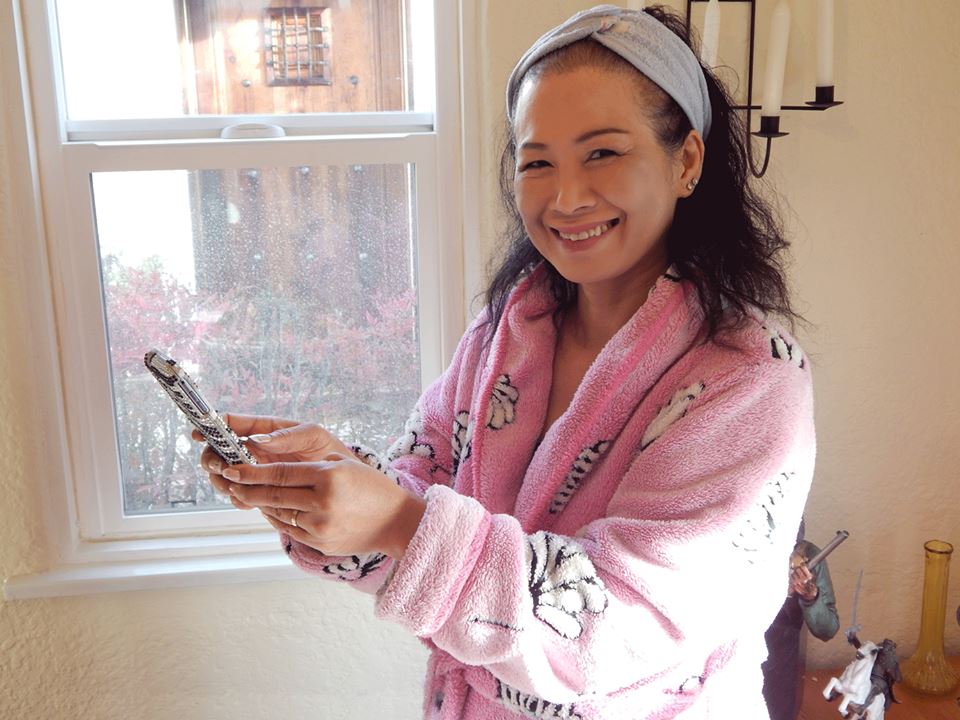
Although this image was taken on 15feb2014, which wasn’t a typical day, it certainly represents Pailin’s mornings. She is full of energy and constantly doing something. (photo © Pailin Subanna-Kraft & Louis Kraft 2014)
Depending upon when she leaves for work, we have three hours and sometimes a little more together. She makes breakfast (everything from soup that is to die for to fish to fried rice w/veggies, tofu, and perhaps chicken or fish and it isn’t fried). We enjoy each other’s company and discuss the future. I do the dishes and make the day’s juice. We then do some chores (from yard work and the place is an overgrown jungle to cleaning before she prepares to leave. The time is easy, fun, special. The parting is tender and sometimes sad for way-too-many hours pass before I see her again.
The minute she’s out the door (and sometimes before) I’m back at the computer pounding keys (some of this is business and not manuscript related). Believe it or not I plot my days and know exactly what I’ll write on any given day. My work load is set: Sand Creek and the Tragic End of a Lifeway, Errol & Olivia, The Discovery, the LK blog, and magazine articles (yep Greg, I do think of you once in a while). I finish the morning with that day’s manuscript. Early afternoon is on the second project (let’s say E&O if Sand Creek had been first), the current blog, and then in late afternoon-early evening medical malpractice (believe it or not I have put in 10 straight hours on the novel more than once).

The hours that Pailin and I spend together in the mornings are special. … A decade or so ago, I relaxed on a hotel bed and switched channels on the TV until I stumbled upon former president Bill Clinton preparing a sack lunch for wife Hillary. By the time he had the lunch ready and packed she had rushed outside to start the car. He grabbed the sack lunch and darted out the front door. His timing perfect he gave her the bagged food as she backed out of the driveway and sped off to work. He waved at the vanishing car. All in fun this short film is hilarious. I wish I knew the title so that I could see it a second time. … Off the top, this is close to how I view Pailin’s exits to work. I make sure she has what she needs for the day, help her carry everything outside, and wave as she drives off. Am I the spitting image of Bill Clinton in the long-lost short as my lady heads off to work? I doubt it. But if yes, I’m good with it. (photos © Pailin Subanna-Kraft & Louis Kraft 2014)
The Sand Creek manuscript has come to life; research (and there is still a ton to do!), constant thoughts, and actual writing. BTW, just because something is on paper it doesn’t mean that it won’t be changed, corrected, or perhaps deleted in the future. As the great NY Yankees baseball catcher Yogi Berra used to say, “It ain’t over ’til it’s over.” (BTW, I’ve seen this quote many times and it changes; I’m not sure if this is the correct Berra quote.) Translation: “The writing ain’t done until it’s published (and it could still need more work).” I hate to say this, but my editors and their publishing teams cringe as my projects move into production for they don’t know what’s going to come out of my mouth, and honestly don’t want to hear it. I firmly believe that the writer should take part in every step—EVERY STEP—of the creative and production cycle.
I once knew a Custer expert who now walks with angels (at least he claimed to be a Custer expert, and I’m guessing that he now walks with angels). His ego was 10 feet wide, and he came off as a blowhard. I never read his books (a short one was perhaps 250,000 words), most of which were privately printed (and you can guess why). One day I asked him if he felt his books could be improved if he edited and wrote them a second time. “Why?” he responded. “There’re perfect.”
Really? If given the chance I would rewrite everything I’ve written for none of it is perfect.
Walking with Tsistsistas
I walk with the Sand Creek story on a daily basis. This doesn’t mean that I write every day. That said, research and thinking are constant. The main problem that I’ve had is how to make the early chapters flow forward in an active voice. Complicating the problem is that in early Cheyenne history the people are nameless. The reason is simple: Early contact with whites often had no one present capable of translating the Tsistsistas’ (Cheyenne) language to English and back. The encounters happened and whites had a hint of who the Indians were but had no idea of individual names or the people who traded with them.
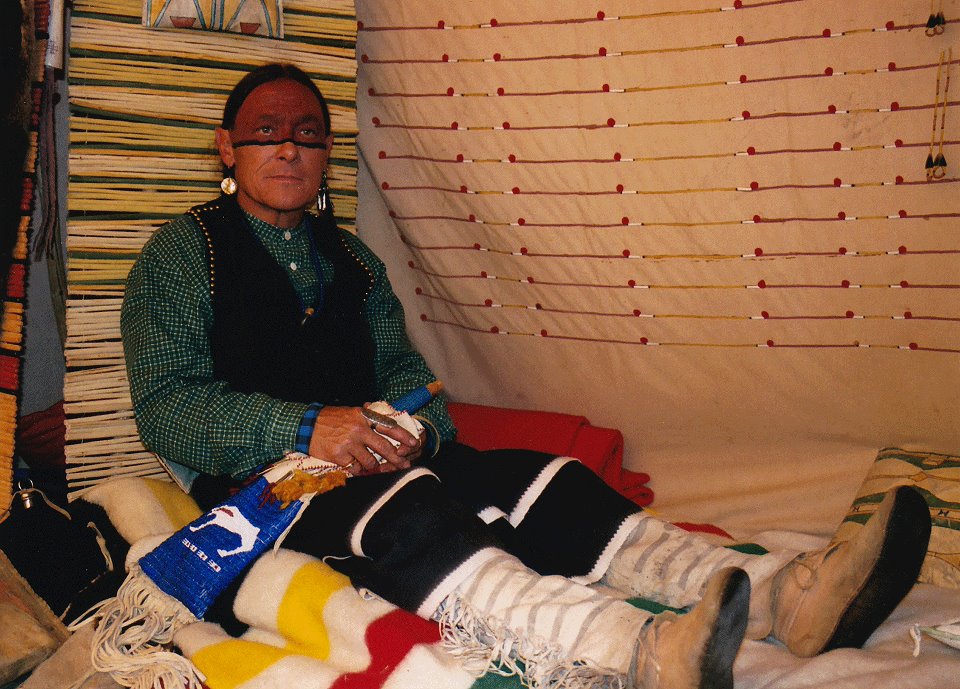
This is Ivan Hankla, a Tsistsista (Southern Cheyenne) that I met for the first time on April 30, 2004, at Fort Larned, Ks. We hit it off immediately and I spent a good part of the Fort Larned Old Guard two or three-day convention hanging out with him and James Coverdale (Kiowa) in Ivan’s tipi or on the boardwalk or parade ground at the post. You are looking at the interior of Ivan’s tipi, which is a good view of how Cheyennes decorated their lodges. He (and James) kindly allowed me to take a number of photos of them on May 1, 2004. On the first I talked about Custer, Stone Forehead, and the Sweetwater village that Custer boldly rode into (March 1869). I asked Ivan and James if they were going to go to the talk, and they told me that they weren’t registered with the convention. I told them to forget that, that they were my guests. I invited them to my talk and they attended it in full native regalia. Ivan would be perfect to assist my Sand Creek manuscript but unfortunately he died a few years back. Our relationship, although mostly long distance, was always like yesterday when we were together. I miss him. (Photo © Louis Kraft 2004)
As Sand Creek and the Tragic End of a Lifeway is dependent upon people actions (mainly Cheyenne and white) the early chapters have presented a problem to me as I’ve chosen to begin the manuscript with early Cheyenne life, development, and migration. Certainly I’ve been writing long enough that I should be capable of composing active prose. This isn’t the problem. In the past my books have all been people driven. Sand Creek will also be people driven, but this won’t begin until chapter 3, and a lot has happened to the Cheyennes by then. Let me put this another way, they had created a tribal structure and lifeway long before the white man entered their lives and began recording encounters.
Actually, the Cheyennes are a merging of two tribes: Tsistsistas (which is the word for Cheyennes) and the Suhtai. Their merging gave “The People,” which “Tsistsistas” means, two sacred objects that have played major roles in their religion, lifeway, and future. The sacred arrows (“Maahótse,” but often written as “Mahuts,” which is a phonetic spelling of how the word is pronounced) and the buffalo hat (Is’siwun).
Sweet Medicine, the Tsistsista culture hero who spent time with Maheo, the Cheyennes’ one God, and received Maahótse, while Red Tassel, the Suhtai culture hero, received Is’siwun. There is no room here to discuss and explain Maahótse and Is’siwun but they play (and played) significant roles in Tsistsista lives (past and present). I must understand and present what Maahótse and Is’siwun mean to the Tsistsistas for Sand Creek and the Tragic End of a Lifeway to live.
I walk with this on a daily basis. Once I have a draft that is readable dealing with this portion of Cheyenne history I hope that Cheyennes Chief Gordon Yellowman, Dr. Henrietta Mann, and Minoma Littlehawk might be open to reviewing the subject matter, along with my pal the great Indian wars and Cheyenne historian John Monnett.
Let me raise a red flag here. How often have you been confronted by a zealot who tells you that you are stumbling around in darkness if you don’t see God as they do? I’m talking about myself, Catholicism, and Christianity here. Why? What makes one person’s beliefs absolute truth when another person’s beliefs, which they may also totally believe, false? Why can’t people accept religious beliefs and other religions that differ from theirs as also valid?
Why do people hate and kill in the name of religion? And worse, why do the victors in war do everything possible to destroy a conquered people’s lifeway, language, religion, and family? Are their lives and beliefs that much of a threat?
Racism dominated the 19th century and American expansion. It’s cliché now, but many Americans (during the conquest of land from sea to shining sea and right on through a good portion of the 20th century) view and viewed people of different races, colors, and cultures as less than human. Reason: The foreign cultures hadn’t developed at the pace or in the same manner as white cultures and thus were inferior. Unfortunately that view still lives, and I for one have faced it and have been accused of being a traitor to my race.
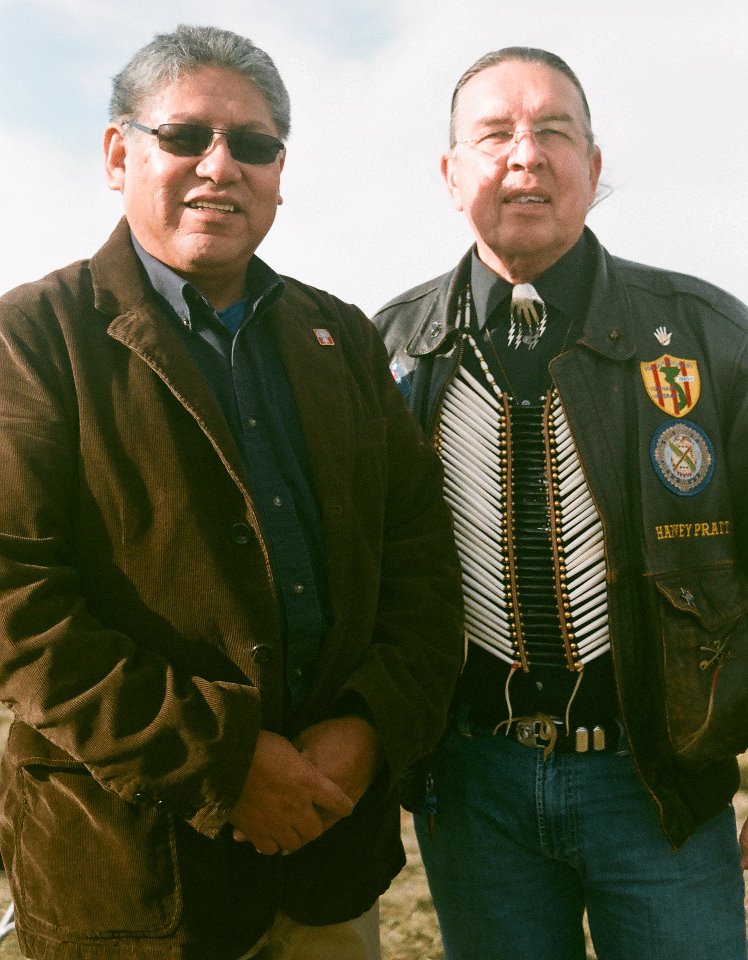
Cheyennes Chief Gordon Yellowman (left) and Harvey Pratt at the Washita Battlefield NHS event on 11nov2011 at the overlook to precious land, sacred land. Upon my arrival before the event began Harvey made a point of meeting me, and we hit it off. On this day Harvey spoke about what it was like to be a Cheyenne warrior during the 1860s and today on foreign battlefields. I met Gordon when he and Cheyenne chief Lawrence Hart blessed the Pawnee Fork Tsistsista-Dog Man-Lakota village in Kansas in 1999. Since then we have spoken at several programs together. Upon seeing me he said, “Your name is all over the place.” The Wynkoop book had just been published. Sounded like he was sick of this, and I didn’t ask what he meant. Gordon is one of the four principle chiefs of the Cheyennes. He blessed the land this day, and delivered a moving talk on what it was like to be a Cheyenne chief at the symposium the next day. (photo © Louis Kraft 2011)
What bullshit!!!
The Cheyennes created an extraordinary culture. They had everything in place, and it was based upon strong religious and moral beliefs and laws. Sand Creek and the Tragic End of a Lifeway isn’t going to be this type of book, so I’ll only be able to hint at the above. That said, by the late 1820s when Cheyennes no longer existed as faceless people, the manuscript becomes people based. People actions (Indian, white, and mixed-blood) will dominate the flow of the manuscript.
High-back Wolf is first to walk out of the mists of obscurity

George Catlin painted High-back Wolf about 1832. The little I know about High-backed Wolf has grabbed my interest, and as he is, at the moment, the first major Cheyenne in the Sand Creek book I want to make him as prominent as possible.
Simply put, High-back Wolf (and he had numerous names including Né-hee-ó-ee-wóo-tis, Wolf on the Hill, and High-backed Wolf) stepped out of the dark mist of obscurity and became the first Cheyenne chief to register big time with whites. Until the 1820s the handful of Cheyenne-white contact had no one present that could translate words. This changed when he not only met with whites, but impressed them. More important, translators matched his actions with his name. Not many years later artist George Catlin painted portraits of him and his wife. Sadly High-back Wolf exited the big picture soon after Catlin captured his image for all time. Enter a second High-backed Wolf, but he, too, died early. Was he related to the first High-back Wolf? His brother? I don’t know, but I will find out.
High-back Wolf had a wife, and someone actually took the time to learn it. George Catlin also painted her in 1832. At the moment I don’t know the ages of High-back Wolf or She Who Bathes Her Knees in 1832 but they don’t look old. I wonder if I’ll be able to learn anything about her other than she was his wife. Fingers are crossed.
Something else has caught my interest. One reference to High-back Wolf questioned if he sired Black Kettle. Whoa! I don’t know, but at the moment I doubt it. Reason: We’re cutting it too close on what I consider the range of Black Kettle’s birth years. Need to dig in my Grinnell notes, for I certainly searched for Black Kettle when researching Wynkoop Ned Wynkoop and the Lonely Road from Sand Creek. However, High-back Wolf’s name doesn’t ring a bell, although I believe that I had seen a father for Make-tava-tah (as Wynkoop called Black Kettle) listed but didn’t use it in the Wynkoop book. If not, hopefully my upcoming visit to the Braun History Library of the Southwest Museum (Autry National Center) will provide an answer. The archive houses a wealth of information that I have not yet seen. High-back Wolf has become a priority. Need to check, but think I’ve got 12 days of appointments set.
Good times are coming for I’ll be back in my element doing research. There is nothing better than mining primary documentation and then trying to figure out what happened and who did what. Francis Drake, John Ward (an Englishman who became a Tunisian pirate), High-back Wolf, Kit Carson, Black Kettle, Tall Bull, Geronimo, Ned Wynkoop, George Bent, Charles Gatewood, Errol Flynn, Olivia de Havilland, LK. I’ve listed people whose lives have reached across over five centuries. And these lives are linked, at least in my brain.
My hope is that I can learn enough about High-back Wolf and write enough about him to justify using the magnificent Catlin portrait of him in Sand Creek and the Tragic End of a Lifeway. Time will tell.
The Discovery
Dr. Robert Goodman has done a masterful job of bringing
a unique form of medical malpractice to life. He’s not a trained writer
and so he falls into a swamp of pitfalls that exist to trap writers.
You should see my markups on my drafts and the verbal
and written abuse I sling at my words.
Luckily my initial training in writing had been writing dialogue, and there is so much you can do with dialogue to move a plot forward. Let me say this in another way. Telling is not good in fiction or nonfiction. Writers must constantly strive to move their plots forward in an active manner. Dialogue, if used properly, it is a great way to move a story forward (it is also a great way to develop and show character).
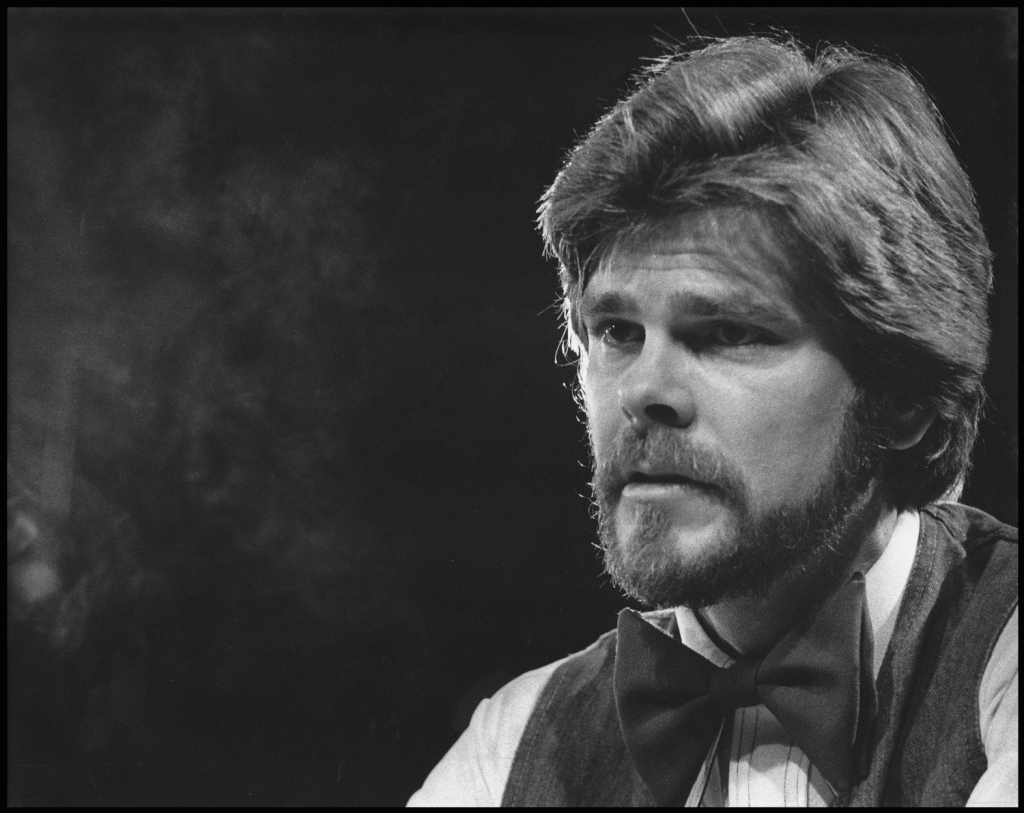
Texas offered leading roles in class productions. It also offered an introduction to life that I hadn’t realized existed. Texas proved to be a good learning experience over the years. (photo © Louis Kraft 1976)
Lubbock, Texas, turned me into a writer
It goes something like this (and this is the short version).
Hell hath no fury like a woman [fill in the blank(s)], and this was certainly true during that 1976 summer I spent in Texas. She was a petite blonde actress in the Theater Department of Texas Tech in Lubbock and she had her eyes on me (I have no images of this lady). Parties at the Hayloft Dinner Theater and elsewhere and I was a fish waiting to be hooked. One problem, this lady wasn’t for me. Racial prejudice that made the racial prejudice I had seen in Texas and Oklahoma in 1970 look like child’s play, a major drug bust that I viewed, in-college theater war, other nasty events, and of course the lady ignored made TV soap operas of the day seem lightweight.
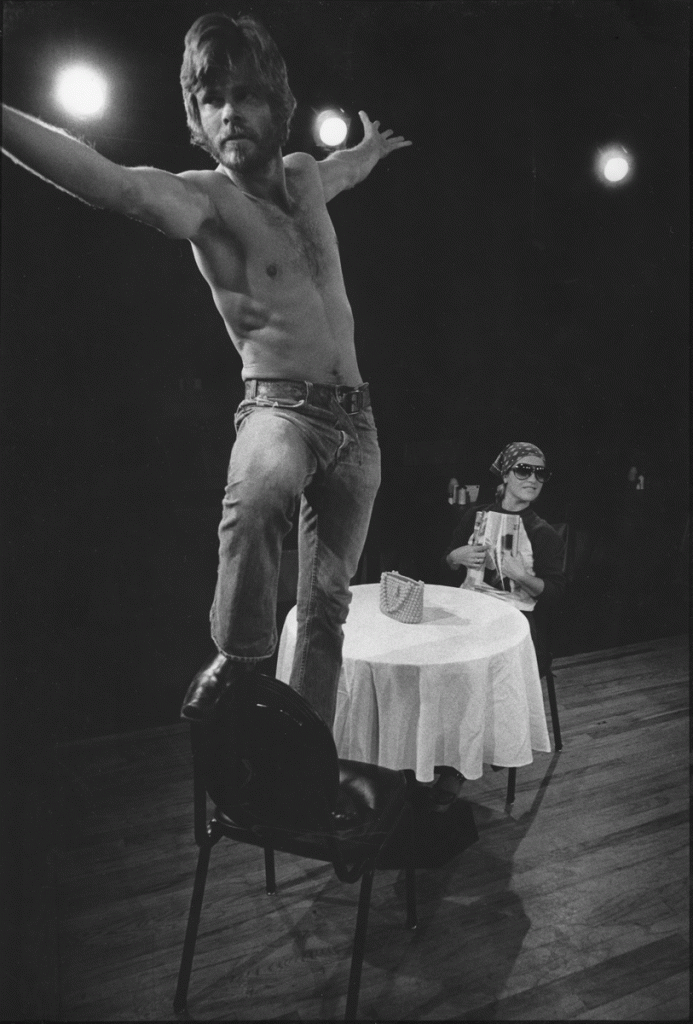
The play was Eat Your Heart Out, and it was the 2nd play of my visit to Texas that summer. It dealt with an actor struggling to survive in LA. Talk about type casting. Certainly sex entered the picture and the director did everything he could to remove my clothes, and that included swinging imaginary swords. The actress in this scene is Robin LaValley. (photo © Louis Kraft 1976)
Nevertheless I had become a marked man. Bottom line: I was lucky to get out of Texas with my scalp in place. After returning home to LA I wrote a screenplay about what I had seen. My then theatrical agency had a literary branch and I submitted the script. Agent Ed Menerth called and said, “This is terrible, but let’s talk.” We did and for the next seven years he represented my screenplays. Race became one of the key themes throughout the dozen or more scripts I wrote including a Persian woman surviving in Los Angeles at the time of the fall of the Shah of Iran, the Englishman turned Barbary pirate John Ward in Tunis, a German U-boat commander’s love for a Jewish woman during WWII, and so on). Menerth reviewed and marked the copy up and I rewrote and rewrote until the scripts became sellable. Bob Sabaroff, one of the key players in the Michael Parks’ Then Came Bronson TV series of 1969-70, also liked the scripts and he, too, reviewed and marked up and I again and again rewrote. It was a great training ground and I learned. This led to selling magazine articles, talks, books, and writing for the software industry. Hell I even sold biographical sketches to an encyclopedia.
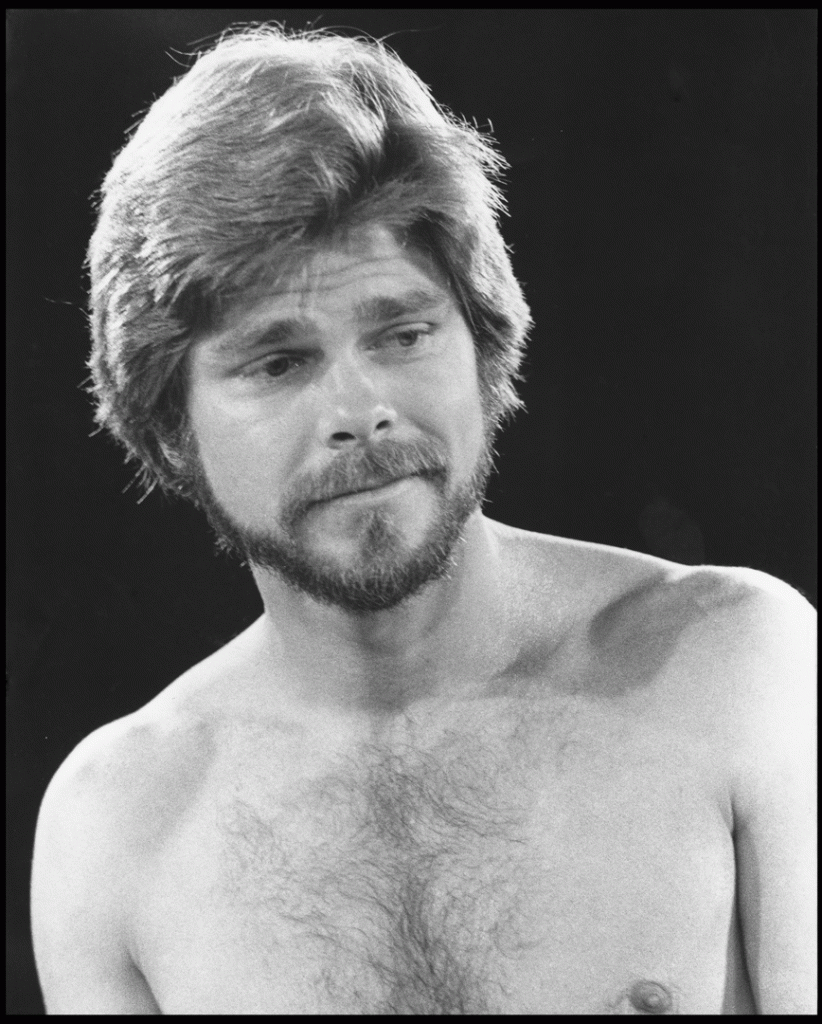
LK in Eat Your Heart Out. I actually played this character twice (the second time was in LA in 1977). I liked playing Charley. The director who came from LA (as did the leading four actors in each play) focused on the sexual image and pushed it as far as he could. Looking back I have no problem with his view of the play. (photo © Louis Kraft 1976)
Over the years I have traveled a long way from the unforgettable racism that I had witnessed up close and center in Texas twice and elsewhere including SoCal. It had been seared into my very being. I realized that, even though I had seen racism from the white POV while in school and had backed off from it without making a stand, that now this was not and could never again be acceptable in my life. Some of this you have perhaps seen in earlier blogs, and for this I apologize. However, it is important to me. I have time and again been called a racist as some of the women in my life have not been white. Yes, believe it or not, some whites don’t like that my lady was Black, Asian, or a Latina, and have let me know. Again, forgive me for repeating myself, but this hurts for these accusations have come from people I’ve considered friends and from people I love or have loved. This accusation is asinine and makes me ill. Enough said about racism for this blog.
Sorry about the lengthy sidetrack, but for me the timing hit the mark.
Introducing Robert Goodman, MD
Bob Goodman (right) at home. Bob has a great house, and he is in a room that is a handful of steps below the entry to his house. This room opens to his swimming pool and has a very livable bar. Bob is sitting at a table that we use when we talk business. When I pulled out my camera he asked: “What are you doing?” “I’m going to take a picture of you.” He agreed, while making it clear he wanted me to shoot a good portrait of him at his office. I agreed, and this will happen soon. … I can’t say enough good things about Bob, other than say I wish you also knew him. (photo © Louis Kraft 2014)
Bob has played a major part in my life for some 25 years as my heart specialist, internist, and GP. Actually if it weren’t for him over a decade ago I’d be long dancing with angels. We’ve enjoyed knowing each other over the years, and a few years back I provided him with editorial help on his writing (various projects).
One, a medical malpractice novel had an exceptional story line. In November 2013 Bob asked me to partner with him. I have. Bob’s subject matter is extraordinary, and because of this we have agreed not to share it until pre-publication publicity begins. My apologies, but this is just how it is. That said, I will be able to talk about manuscript progression and I will.
All I can say at this point in time is that the story is character driven and although The Discovery is fictional the facts are based upon reality. When I complete writing and polishing the manuscript, we will deliver a story that captures our readers’ interest and will not let go until the last page.
A tall order but it will happen.
Greg Lalire and Captured
I’ve hinted that Greg Lalire and I are friends. We are. Over what seems like a lifetime he has done everything possible to get my words in print, and has done everything to publicize a writer named Kraft. I’m forever grateful. But this section isn’t based upon Greg’s kindness to me, it’s based upon me knowing him, a special person even though our relationship is mostly long distance.
Five Star Publishing releases Greg’s novel, Captured: From the Frontier Diary of Infant Danny Duly, in July 2014. The June 2014 Wild West magazine features a full-page ad next to the table of contents. A perfect placement and appealing layout by the Weider History Group design staff. To scan the ad would have required mangling the magazine or pulling it apart and I didn’t want to do that. Captured features historical characters Chief Red Cloud, Col. Henry Carrington, and Capt. William Fetterman. The ad’s blurb (I assume from the dust jacket flaps) states:
“Libbie Duly, pregnant and with her husband confined to the local insane asylum, leaves Chicago in 1866 for booming Virginia City, Montana Territory. On the Oregon Trail she gives birth to the remarkable Danny Duly, who already began narrating this emigrant tale from the womb. Danny has the rare ability to see with his mind’s eye and record events he hopes to later put down on paper. Along the dangerous Bozeman Trail, Libbie and son fall into the hands of Sioux warrior Wolf Who Don’t Dance, and the emigrant story becomes a captivating captivity narrative.”
Captured will be published on July 16, 2014. It is currently available for pre-order on amazon.com with a price guarantee.
Am looking forward to reading it Greg, and so is my good pal Glen Williams (to whom I shared your Captured publicity).
Weider History Group is a class company, and Eric Weider has done an extraordinary job of obtaining and retaining class editorial and design staff. This is an understatement. Eric, you and everyone you designate to make hiring decisions know what you are doing. Your staff from A to Z with “Lalire” being first on the list is extraordinary. My hope is that your entire selection of historical publications expand and grow in ways that guarantee their continued existence throughout my, Greg’s, and your lifetimes. You and your entire staff produce product that needs to live forever.
I’m honored to play a small role in Weider History Group’s product line.

